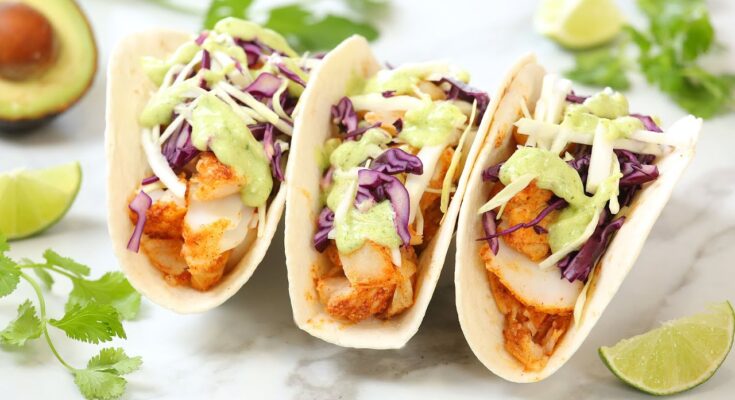Fish Taco Sauce Recipe: Ever had a taco that was just okay? Odds are, it was missing one key component: a killer sauce. Fish taco sauce is more than just a condiment—it’s the heart of flavor in your fish taco experience. It brings everything together with a punch of zest, creaminess, and spice. Whether you’re grilling, baking, or frying your fish, the right sauce can transform your tacos from plain to unforgettable.
Why Fish Taco Sauce is a Game-Changer
Think of it like this: even the best-cooked fish can taste dry or bland without the right partner. That’s where the sauce jumps in. Fish taco sauce adds moisture, boosts flavor complexity, and creates that wow factor. Whether you’re making Baja-style tacos or a fusion twist, a flavorful sauce can carry the entire dish.
The Role of Sauce in Elevating Tacos
A great sauce not only complements the fish but also ties together all the other taco toppings—cabbage slaw, fresh pico de gallo, avocado, and lime. It provides the creamy contrast to crispy textures and spicy notes, balancing everything in one magical bite.
Essential Ingredients for Fish Taco Sauce
Making your own sauce at home means you can tweak it exactly to your liking. The base ingredients are simple, but the variations are endless.
Commonly Used Ingredients
Here’s what you’ll typically find in a classic fish taco sauce:
- Mayonnaise: Adds richness and creaminess.
- Sour cream or Greek yogurt: Balances the mayo with a tangy note.
- Lime juice: For acidity and freshness.
- Garlic powder: Provides a subtle, savory depth.
- Cumin or chili powder: Adds warmth and spice.
- Salt & pepper: Essential for balancing flavors.
Optional Add-ins for a Flavor Boost
To dial it up, consider adding:
- Hot sauce or sriracha for heat
- Fresh cilantro for herby brightness
- Smoked paprika for depth
- Chipotle in adobo sauce for a smoky, spicy kick
- Pickle juice or vinegar for extra tang
Feel free to get creative depending on what kind of flavor profile you’re going for.
Kitchen Tools You’ll Need
Before diving into the recipe, make sure you’ve got the right tools handy. Nothing fancy—just some basics to make your sauce mixing a breeze.
Basic Utensils
- Mixing bowl (medium-sized)
- Whisk or spoon for stirring
- Measuring spoons
- Citrus juicer (optional but helpful for lime juice)
Pro Tips for Mixing and Storing Sauce
- Use a glass bowl if possible, as it doesn’t retain flavors or stains.
- For a smoother consistency, a hand blender can help emulsify the sauce.
- Store the sauce in an airtight container or a squeeze bottle for up to a week in the fridge.
Step-by-Step Guide to Making Fish Taco Sauce
Let’s walk through the process together—it’s quick, easy, and oh-so-rewarding. In just five steps, you’ll have a sauce worthy of your best fish tacos.
Step 1 – Gathering Your Ingredients
First, lay out everything you’ll need. Here’s a basic list to follow:
- ½ cup mayonnaise
- ½ cup sour cream
- 2 tablespoons lime juice (freshly squeezed)
- 1 teaspoon garlic powder
- ½ teaspoon chili powder
- Salt and pepper to taste
Gather these on your counter so everything is within arm’s reach before you start mixing.
Step 2 – Mixing the Base
In a mixing bowl, combine the mayonnaise and sour cream. Use a whisk to blend them until the mixture is smooth and uniform. This creamy base sets the foundation for your sauce and gives it that luscious texture.
Step 3 – Adding Flavors and Spices
Now it’s time to throw in the lime juice, garlic powder, chili powder, salt, and pepper. Stir it all together and notice how the color starts to shift slightly as the spices blend in. If you want it spicier, go ahead and add a dash of your favorite hot sauce.
Step 4 – Taste Testing and Adjusting
This is the most important part—don’t skip it! Take a spoonful and give it a taste. Want more zing? Add more lime. Need more heat? Add some cayenne or sriracha. Adjust until the balance of creamy, tangy, and spicy is just right for your taste.
Step 5 – Storing Your Sauce
Transfer your sauce into a container with a lid, and pop it in the fridge. Letting it chill for at least 30 minutes enhances the flavors even more. It’ll thicken slightly and become even more delicious. Trust me—it’s worth the wait.
Variations of Fish Taco Sauce
Everyone has a different take on what makes the perfect fish taco sauce. Maybe you like it fiery and bold. Or maybe you’re after something light and zesty. The beauty of this sauce is in its flexibility. Here are two fan-favorite variations you’ve got to try.
Spicy Chipotle Style
Want a bold, smoky kick to your tacos? The Chipotle version is where it’s at. This variation uses chipotle peppers in adobo sauce, which adds a deep, smoky heat and a gorgeous reddish hue.
Ingredients:
- ½ cup mayo
- ¼ cup sour cream
- 2 tablespoons lime juice
- 1–2 chipotle peppers in adobo sauce (minced or blended)
- 1 teaspoon garlic powder
- ½ teaspoon smoked paprika
- Salt to taste
Directions:
- Blend the chipotle peppers into a paste.
- Mix with the mayo, sour cream, lime juice, and spices.
- Stir thoroughly until smooth.
- Taste and adjust seasoning. Want it spicier? Add another chipotle pepper or a teaspoon of the adobo sauce.
This variation pairs incredibly well with blackened or grilled fish, giving your tacos that unforgettable smoky depth. Pro tip? Use it as a dipping sauce for fries or drizzle it over nachos—thank us later!
Cilantro Lime Cream Sauce
For a lighter, fresher take, this variation is bursting with herbaceous, citrusy flavor. It’s perfect if you prefer a sauce that doesn’t overpower your fish.
Ingredients:
- ½ cup Greek yogurt (or sour cream)
- ¼ cup mayo
- Juice of one lime
- Zest of one lime (optional, for extra punch)
- 1 garlic clove (minced or grated)
- ¼ cup fresh cilantro (chopped finely)
- Salt and pepper to taste
Directions:
- Combine yogurt, mayo, lime juice, and zest in a bowl.
- Add garlic and chopped cilantro.
- Stir well and season with salt and pepper.
- Let it sit in the fridge for 15–30 minutes before serving to let the flavors develop.
This cilantro lime version is like sunshine in sauce form. It’s light, tangy, and perfectly complements fried or beer-battered fish, making it a must-try for your next taco night.
FAQs about Fish Taco Sauce Recipe
1. What is the best sauce for fish tacos?
The best sauce for fish tacos is typically a creamy blend made with mayonnaise, sour cream or Greek yogurt, lime juice, and seasonings like garlic, cumin, and chipotle. This combination adds tangy, spicy, and savory flavors that complement grilled or fried fish perfectly.
2. Can I make fish taco sauce ahead of time?
Yes! You can make fish taco sauce up to 3 days in advance. Store it in an airtight container in the refrigerator to let the flavors develop even more.
3. Is fish taco sauce spicy?
That depends on your recipe. Traditional versions may include hot sauce or chipotle for a spicy kick, but you can easily adjust the heat by reducing or omitting spicy ingredients.
3. Is fish taco sauce spicy?
Absolutely. Greek yogurt is a healthy alternative that still offers creaminess and tang. It’s a great choice if you’re looking for a lighter version of the sauce.
5. What other ingredients can I add to customize my sauce?
You can mix in fresh cilantro, minced jalapeños, avocado, or even honey for a unique twist. Adjust the ingredients based on your taste preference and the style of your tacos.
Conclusion
There you have it—a step-by-step guide to making the ultimate fish taco sauce, complete with two delicious variations to suit every palate. Whether you go with the classic creamy version, turn up the heat with chipotle, or keep things fresh with cilantro lime, you’re guaranteed a mouthwatering addition to your tacos. And the best part? It’s all homemade, meaning no preservatives, no artificial stuff—just pure flavor. So, next time you’re serving up fish tacos, don’t forget to whip up one of these sauces. Your taste buds (and your dinner guests) will thank you.



